A few things I think about this place
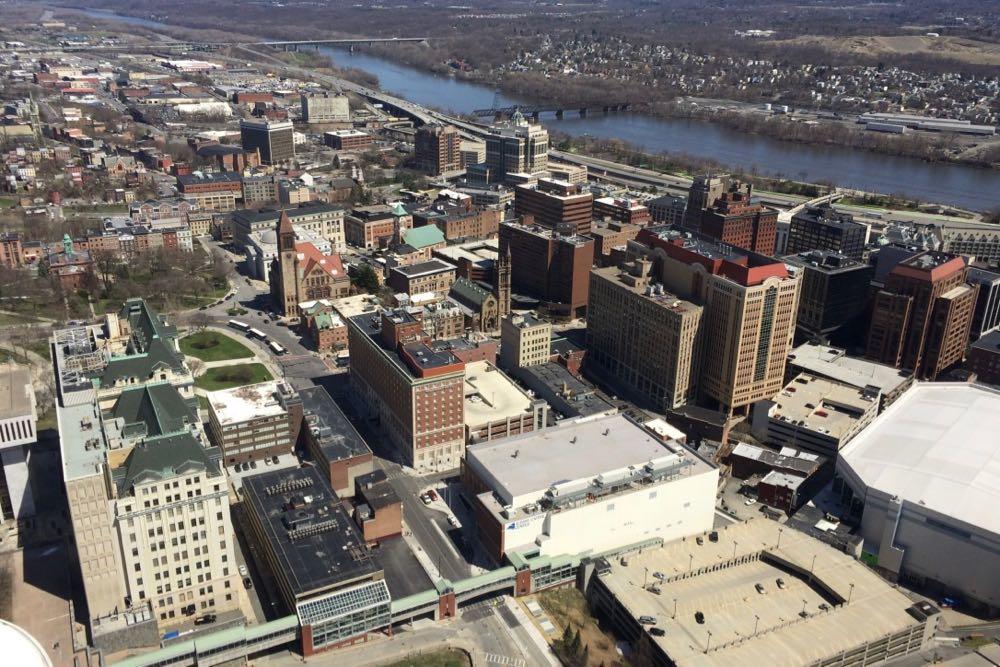
I also think you go up to the observation deck of the Corning Tower sometime.
Working on AOA over the past decade has been a life-changing experience for me and it's shaped the way I think about so many things. It will probably be years before I fully realize how much.
As part of my own effort to take stock of all this, here are a few thoughts I have about this place.
This is a good place to live

I believe that Albany is a good place to live. Working on AOA has made that belief even stronger.
It is a city of wonderful neighborhoods, compelling architecture, walkable streets, lovely parks, inspiring history, interesting places to eat, and diverse people working to make it a livable community. It's part of a region that includes all sorts of cities and towns and villages with their own distinct sense of place. You can wake up and be standing in a blueberry field 45 minutes later. You can hike a mountain and be back home for dinner.
Could this place be better? Of course. And it will never be like New York City or Seattle or San Francisco or even Austin. That's OK. It's fine that some people may prefer those larger cities over this one. Not every place is going to work for every person.
But those people will be missing out.
We all experience this place differently
One of the patterns I've encountered over and over again is that people who have moved here from somewhere else tend to be more optimistic about this place than people who have lived here a very long time. At first I thought it was just something I was reading into conversations, but I've had a bunch of fellow not-from-here people tell me something similar.
I don't have a good theory about why that might be. Maybe it's a product of actively making a choice to come here. Maybe it's people who have set foot in the grass on the other side of the fence and decided it's not actually as green as it appears. Or maybe people who have lived here a long time feel the weight of what have been some hard decades for the city.
All of this is to not make the case that some people are right and others are wrong in their perceptions. Instead, the point I take from this split is that we all experience this place differently based on who we are and our personal histories. And it's worth taking the time to listen to people and try to understand why they feel the way they do about this place.
Albany needs more people
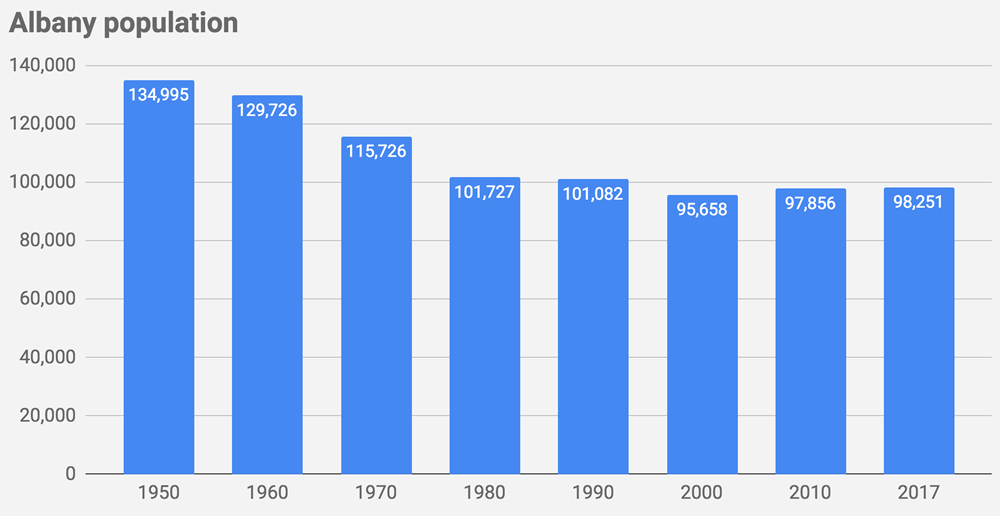
One of the characteristics of those hard decades: population loss.
The city of Albany hit a population of almost 135,000 people in the 1950 Census and then steadily lost population each decade until 2010 when it registered a small uptick. It's now at 98,251 in the latest Census estimates. (Troy and Schenectady have experienced similar population swings.)
The city's future depends in part on attracting more residents, to fill vacant buildings in hollowed-out neighborhoods, to help support neighborhood commercial strips, to provide new ideas, and yep, to pay taxes to keep the city afloat. That won't be easy, but after swimming against the currents of suburbanization and disinvestment for so long, it does look like the tide is starting to turn. This is the moment to paddle for the wave.
A significant population gain will mean some adjustments. One of them will be people getting used to the idea of increased density and congestion because it's going to be hard to add another 10,000 or 20,000 people to the city without denser neighborhoods. Good planning can help with some of the changes, but at some point more people are more people. The upside is that renewed density will make a lot of the things that people say the want -- like walkable neighborhood retail -- more possible.
Albany also needs to more explicitly argue its case as a place where people want to live. I'm not a fan of zero-sum thinking because it's often an inaccurate model of the world that ends up closing off opportunities where everyone can win something, but there is a zero-sum aspect of the population situation here. The Albany metro area's population is growing, but not quickly. Every municipality here is competing against the others for a slice of a pie that's staying roughly the same size.
Arguing Albany's case can take a bunch of forms. Part of it is continuing to set the stage for the development of new housing choices, including affordable options, and investing in quality of life improvements. Others could be more personal, like a network of families available to provide answers and encouragement to young families who are making the decision about whether to stay in the city. And some of it might just be as simple as repeatedly pointing out to all those people who stream into the city each day for work that they could be living in a nice neighborhood, near their job, with an easier commute.
We are all in this together
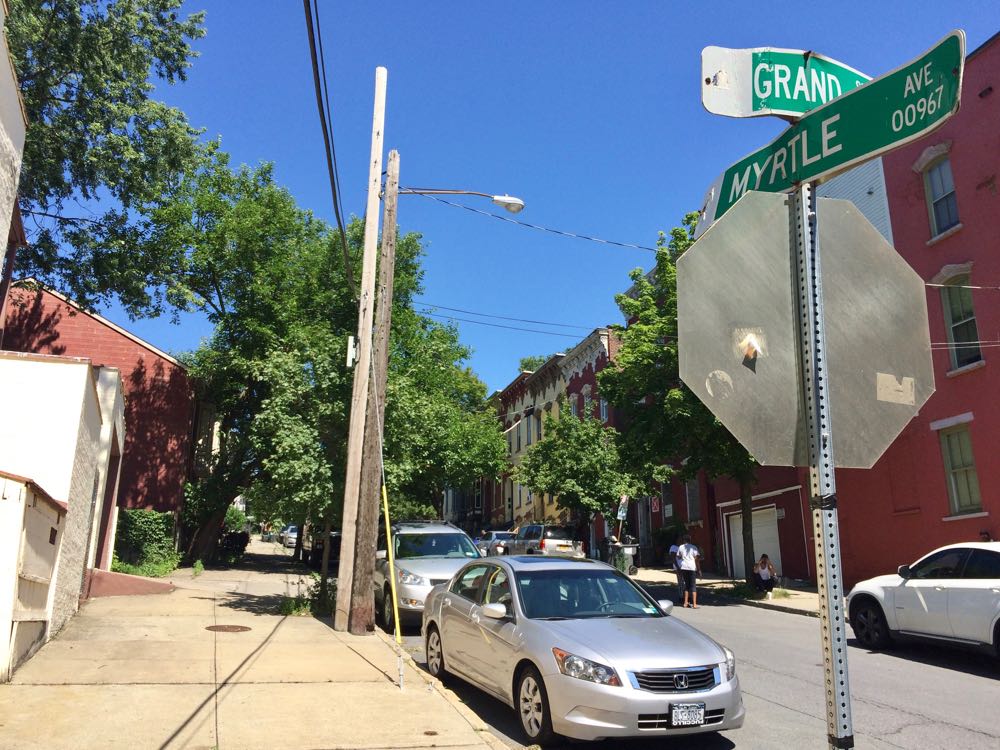
One of my favorite AOA posts was about walking the entire length of Myrtle Ave in one afternoon. Doing that really makes clear some of the ways the city's neighborhoods are connected.
The geographic structure of the Capital Region sometimes makes it feel like all the various parts of it -- even neighborhoods within cities -- are far apart from one another. That can make it seem like a problem or struggle across some border -- geographic, economic, racial -- isn't connected to where you're at. But it is. A walk can make that clear.
The future success of the city of Albany will in large part be judged on how well we all can help the neighborhoods and people who have struggled in recent decades find new life. Because all our fortunes are tied together.
There's a fractal quality to this situation. If you're concerned about this region, then you need to be concerned about its cities. If you're concerned about its cities, you need to be concerned about its neighborhoods. If you're concerned about the neighborhoods, then you need to be concerned about the blocks with vacant buildings. And if you're concerned about the blocks, then you need to be concerned about the people who live on them, their struggles and ideas for change.
In this sense, the problems of all these people, all these neighborhoods, all these cities are all our problems.
We need to invest in public spaces
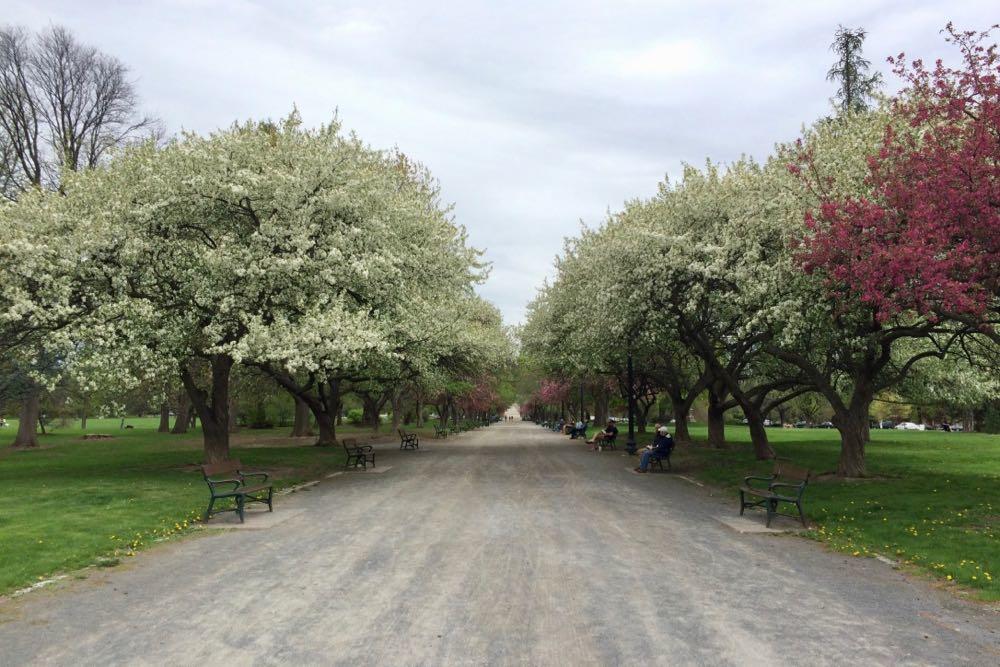
Maybe more than anything, working on AOA has convinced me of the need for investment in public spaces: parks, playgrounds, schools, well-designed streets, sidewalks, and so on.
These public amenities can greatly contribute to our quality of life. They can be places were all sorts of people should be able to interact. And they're a key part of making the city an attractive, vibrant, and equitable place to live.
To go along with this investment in actual physical public spaces, we also have to pay attention to the interactions of public life. Among them: local officials doing a better job of explaining their choices, police doing the work to develop healthier relationships with communities, and all of us making a good-faith effort to offer constructive feedback about how to solve problems.
We should be moving around differently
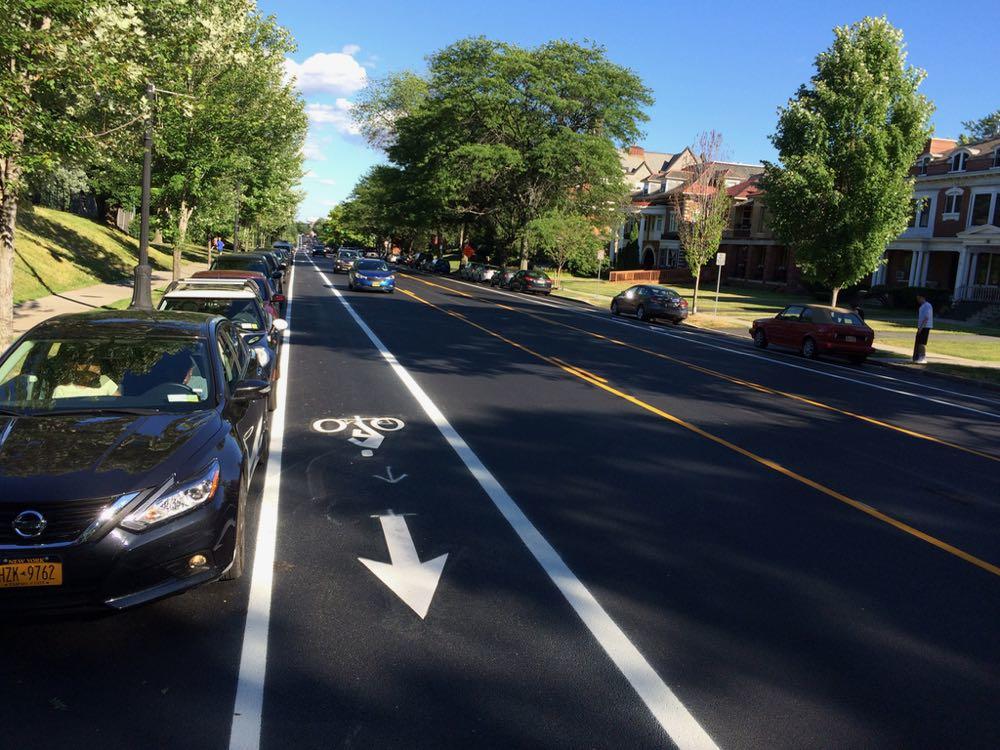
The "road diet" section of Madison Ave.
You know how much I love to walk and ride my bike because I never shut up about it. But in case I haven't been clear: I think the world would be a better place if people walked more, rode a bike more often, and took trips on the bus. Doing so would make for a safer, more humane city and a better environment.
So much of encouraging people to walk or bike is about choices we collectively make in how land is used, how streets are designed, and investments made in public transit. There need to be networks of infrastructure that both are safe and feel safe before people will make the shift.
That's entirely possible. We just need to make it a priority and follow through with our choices.
We've gotta show up

I have been to so many public meetings over the last decade and I'm always heartened to see a packed crowd of people listening and providing feedback on topics ranging from police body cameras to the design of a park. I've been impressed by the thoughtful input people have contributed and the time they've spent to be witnesses to the process of local government. Being present can shape the direction of the city.
It's often the case that people show up when they're upset about something. That's understandable. But I've also come to believe that it's important to show up if you support something because it provides a more accurate view of how the community feels about an issue. Otherwise the critics fill the frame.
Part of providing the fuller picture is having all sorts of people show up at meetings. That's especially true for younger people, because the crowds at community meetings often skew older. If this will be your city for decades to come, that's good reason to say something.
Another part of showing up is listening, making sure we don't have half the facts while being 100 percent certain, and then figuring out a way to offer constructive criticism. It's fine to say "not like that," but it's often better to say "more like this."
Change is hard -- and it's necessary
One of the hardest arguments to make is that you love something and also want it to be better. People will often hear the first part and ignore the second -- or they get hung up on the criticism while not acknowledging that you're working from a position of appreciation and respect.
But these sorts of arguments are vitally important because they're often how we map out a better future. That's hard -- change usually is, especially when a place has been a certain way for so long. It requires us to reexamine our assumptions and expand our imagination for what's possible. Stretching in those ways can be painful, but the alternative is to become brittle and stuck.
I think this place can be a better version of itself, that it can work better for more people.
And I believe that because I love this place.
Greg Dahlmann was one of the co-founders of AOA.
Hi there. Comments have been closed for this item. Still have something to say? Contact us.
Comments
Like so many pieces on AOA over the years, this is packed with valuable perspective and insight into the area we call home. Pieces like this just highlight how much this site, and all of AOA’s many contributions to your readers’ enjoyment and appreciation of life in the Capital Region will be missed. I didn’t grow up here, but I’ve lived here for decades and AOA helped make life here better (and helped me to better appreciate what was already here before you began publishing). Thank you all for that ... as I said, you all will be missed.
... said KJS on Dec 31, 2018 at 5:25 PM | link
Gonna miss you. The TU does a credible job covering Albany but you were the real deal. I'm an adopted Albany denizen of 40years and just can't imagine a more livable town. Yes, it's a company town (NYS) and still has a residual Corning/O'Connor legacy but positive change is apparent and in the right direction. Just look at Pearl Street and the residential renaissance happening now.
Thanks for your coverage and whatever your next adventure is, I wish you the best.
Happy New Year!
... said Paul on Dec 31, 2018 at 7:42 PM | link
Thanks for all you've done!
... said Jay on Jan 1, 2019 at 7:57 AM | link
A very valuable read and opinion. Albany is new to my "new family" and we see a lot of potential. We've enjoyed Colorado, California, D.C., various places in Europe and Albany has a great foundation to grow from. A more active society here coupled with beauty improvements of the city can lift the spirits of the old and new comers easily I believe. Thanks Greg!
... said Andrew on Jan 1, 2019 at 11:26 AM | link
Couldn't agree more with what you said.
Good luck in your future endeavors and thank you!
... said Steve p on Jan 1, 2019 at 5:42 PM | link
Great article, as usual, Greg. Thanks for making Albany an interesting place!
... said Dave Hochfelder on Jan 1, 2019 at 7:38 PM | link
Right on the money, Greg. Albany really needs voices like yours.
... said Jason on Jan 2, 2019 at 12:45 AM | link
We left Albany for Austin in 2011. The move felt necessary for us, not because we disliked the Capital District - it was more of a taxes, weather, job growth thing for us.
I did enjoy this blog as a connection to our old home. When you leave a place after so long, no mater the reasons, you'll miss it. For me it's things like:
Washington Park. Beautiful, one of the great city parks in the USA.
Traffic. I thought it was bad when I lived there. It's not! Austin roads are jammed 7 days a week, and it wears you out.
Pizza/Italian food. Don't get me started.
Lark Fest/Tulip Fest. Get past the parking nightmare, and these are two top notch community events.
State Museum - Better than most people are willing to credit it for. Some marvelous things there to see.
Thatcher Park. How is this not world famous? What a beautiful place with just incredible views!
I visit Albany a couple of times a year now (btw, very expensive place to fly to!), and the changes are positive. Austin is different, and it's hard to compare these two cities apples to apples - almost unfair. But Austin lacks history like Albany has. It lacks the several generations of my family line that have lived their entire lives and are buried in Albany. There are many wonderful things about our life here in Texas, but I feel Albany will always be our home.
... said Mike on Jan 2, 2019 at 6:40 AM | link
SPOT ON!!!
... said Martin Daley on Jan 2, 2019 at 9:33 AM | link
Greg, I love this piece. To echo what Dave said, you and AOA have played a part in making Albany more interesting & great. Thanks for all you've done.
... said Jen Ceponis on Jan 2, 2019 at 11:33 AM | link
Thanks for all you've done for Albany, Greg.
... said Jeremy on Jan 2, 2019 at 2:48 PM | link
I am one of those transplants that sees that value in this area. After growing up downstate I lived on the west coast from my 20s to early 30s. While I lived in some wonderful places they all have downsides. I appreciate your grass isn't greener comment as I have long said it's simply a different shade wherever you go.
We have...
- 4 wonderful seasons
- an affordable housing market
- a reasonable cost of living
- a sufficient number of job and career opportunities
- a large enough town to draw quality music and have interesting and diverse restaurants,but small enough that you feel like everyone is your neighbor
- the ablility to be in the country in minutes
- more that a few mountains to climb (will be completing my 46 this spring)
Yeah, we all see things we'd like to improve. With so many positives there is little reason to go elsewhere. Put your energy into making this wonderful town what you want, because it's got a great foundation to build on.
... said jzip on Jan 2, 2019 at 4:58 PM | link
This is a great read that hits on a lot of solid points - many of which I agree with. I moved to Albany from New York City, and lived there fro 5 years before recently moving to another major metropolitan city. I've thought a lot about Albany, it's potential, and its shortcomings.
To add to what you have: I think if the city found a way to seamlessly connect Troy, Hudson, and downtown Albany via public transportation (perhaps an Amtrak), that had a relatively low-cost, accessible, and reliable way to get people from one to the other, that would be a huge addition to the city. A better public transportation system in general would be great.
A lot of people, especially the younger generations, move to cities to pursue education - not just undergrad, but law school, med school, etc. Unfortunately, Albany Med and Albany Law aren't mid, much less high-ranked institutions. I'm not saying they're bad, but they don't attract top out-of-city/state candidates. I don't have a solution to this, but it's an observation. In general, Albany as a whole has a hard time attracting and retaining top-talent. I personally moved because I couldn't find a solid finance/economics job outside of state government, which paid extremely low compared to industry standards. I'm sure that's true for many other fields as well.
For what it's worth, I miss Albany and feel that even in the four or so months that I've been gone, it's changed fairly dramatically with tons of new successful establishments popping up all over the city. I'm excited to visit in 5/10/20 years from now and see what the citys grown to become.
... said Katherine on Jan 4, 2019 at 11:19 AM | link